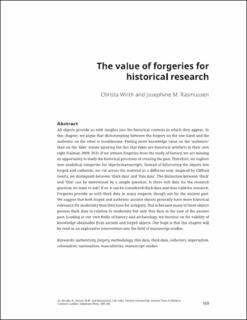| dc.contributor.author | Wirth, Christa Santina | |
| dc.contributor.author | Rasmussen, Josephine Munch | |
| dc.date.accessioned | 2024-03-19T09:43:19Z | |
| dc.date.available | 2024-03-19T09:43:19Z | |
| dc.date.created | 2022-11-14T09:46:16Z | |
| dc.date.issued | 2023 | |
| dc.identifier.citation | Wirth, C. S. & Rasmussen, J. M. (2023). The Value of Forgeries for Historical Research. In N. Brodie, M. M. Kersel & J. M. Rasmussen (Eds.), Variant Scholarship: Ancient Texts in Modern Contexts (169 - 187). Sidestone Press. | en_US |
| dc.identifier.isbn | 9789464270464 | |
| dc.identifier.uri | https://hdl.handle.net/11250/3123044 | |
| dc.description.abstract | All objects provide us with insights into the historical contexts in which they appear. In this chapter, we argue that dichotomizing between the forgery on the one hand and the authentic on the other is troublesome. Putting more knowledge value on the 'authentic' than on the 'fake' means ignoring the fact that fakes are historical artefacts in their own right (Salman 2009: 263). Ifwe jettison forgeries from the study ofhistory, we are missing an opportunity to study the historical processes of creating the past. Therefore, we explore new analytical categories for objects/manuscripts. Instead of bifurcating the objects into forged and authentic, we cut across the material in a different way: inspired by Clifford Geertz, we distinguish between 'thick data' and 'thin data'. The distinction between 'thick' and 'thin' can be determined by a simple question: Is there rich data for the research question we want to ask? If so, it can be considered thick data and thus valid for research. Forgeries provide us with thick data in many respects, though not for the ancient past. We suggest that both forged and authentic ancient objects generally have more historical relevance for modernity than they have for antiquity. This is because many of these objects possess thick data in relation to modernity but only thin data in the case of the ancient past. Looking at our own fields of history and archaeology, we theorise on the validity of knowledge obtainable from ancient and forged objects. Our hope is that this chapter will be read as an explorative intervention into the field of manuscript studies. | en_US |
| dc.language.iso | eng | en_US |
| dc.publisher | Sidestone Press | en_US |
| dc.relation.ispartof | Variant Scholarship: Ancient Texts in Modern Contexts | |
| dc.title | The Value of Forgeries for Historical Research | en_US |
| dc.type | Chapter | en_US |
| dc.type | Peer reviewed | en_US |
| dc.description.version | publishedVersion | en_US |
| dc.rights.holder | © 2023 The Author(s) | en_US |
| dc.subject.nsi | VDP::Humaniora: 000::Arkeologi: 090 | en_US |
| dc.source.pagenumber | 169-188 | en_US |
| dc.identifier.doi | https://www.sidestone.com/books/variant-scholarship | |
| dc.identifier.cristin | 2073235 | |
| cristin.qualitycode | 1 | |
